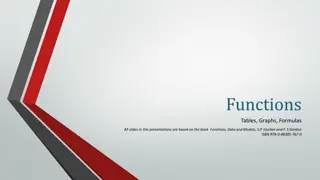Understanding Brakes in Automobiles: Types and Functions
Brakes in automobiles play a crucial role in ensuring safety and control while driving. They help in slowing down or stopping the vehicle when needed, controlling movement on slopes, and navigating through heavy traffic. This content covers the functions, types, and components of brakes, including drum brakes, disc brakes, and hydraulic brakes. Understanding the mechanisms and variations in brakes is essential for safe and efficient driving.
Download Presentation

Please find below an Image/Link to download the presentation.
The content on the website is provided AS IS for your information and personal use only. It may not be sold, licensed, or shared on other websites without obtaining consent from the author. Download presentation by click this link. If you encounter any issues during the download, it is possible that the publisher has removed the file from their server.
E N D
Presentation Transcript
Functions of Brakes To slow down or to stop the vehicle as and when required. To control the vehicle when the vehicle is rolling down on a slope road down ward. To travel smoothly and safely even in heavy flow of traffic by controlling the movement of the vehicle. Requirement of Automobile Brakes The brakes must stop the vehicle within shortest possible distance. These must be released suddenly after releasing them Total control of the vehicle should be there.
Types of Brakes According method of Actuation Mechanical brakes Hydraulic brakes Vacuum brakes Air brakes According to Construction Drum brakes Disc brakes According to purpose Service brake Parking brake According to extra braking effort Servo or Power-operated brakes
Drum Brakes Brake drum attached to axle hub. Back plate is attached on axle casing. It provides support for expander, anchor and brake shoes. It also protect the drum & shoe from mud & dust. Moreover it also absorb the torque reaction of shoe torque plate. Friction lining is mounted on brake shoe. One or two retracting spring is used to keep brake shoe away from drum when brake is not applied.
Drum Brakes Brake shoe are anchored at one end and on other end Force F is applied by means of actuating mechanism. Adjuster is provided to compensate for wear of friction lining. Fixed expander / Floating expander. Fixed anchor / Floating anchor.
Disc Brakes It consists of disc of cast iron is bolted to wheel hub & stationary housing called caliper. Caliper is casted in two parts each containing piston. Friction pad is provided between each piston and disc. Passages are provided in caliper for fluid to enter or leave each housing. These passage is also connected to another for bleeding.
Master Cylinder It is the most important part of hydraulic braking system . It contains Two main chambers . Fluid reservoir which stores the brake fluid in it Barrel-which is compressor and develops pressure in brake fluid. (i) (ii)
Master cylinder (a) Primary cup (b) Piston (c) Secondary cup (d) Return spring (d) Return spring (e) Check valve .
Bleeding of Brakes in Hydraulic brakes. 1. At first check all the pipe lines and junction boxes from master cylinder to wheel cylinder. Whether there is any leak among them. 2. Ask one person to pump the brake pedal and keep it in pressing position 3. The second person should loosen the bleeding screw at the back plate of the wheel cylinder position. 4. Keep the bleeding screw in open until the air bubbles disappear and the brake fluid comes out with a force . Collect the brake fluid in a glass tumbler. 5. Then tighten the bleeding screw. 6. Repeat this process in all the wheel cylinders starting from the farthest wheel to the master cylinder and ending with the nearest wheel. 7. Make sure that the level of brake fluid in master cylinder is less than the top covers while filling it.
Vacuum Brake First Type : Release condition piston are exposed to atmosphere. Applying brake one side of piston is subjected to vacuum of engine which cause the differential pressure & operates the linkage mechanism. Second type: Release condition both side of piston is subjected to vacuum. To apply brake one side of piston will be exposed to atmosphere which provides desired force on the piston.























